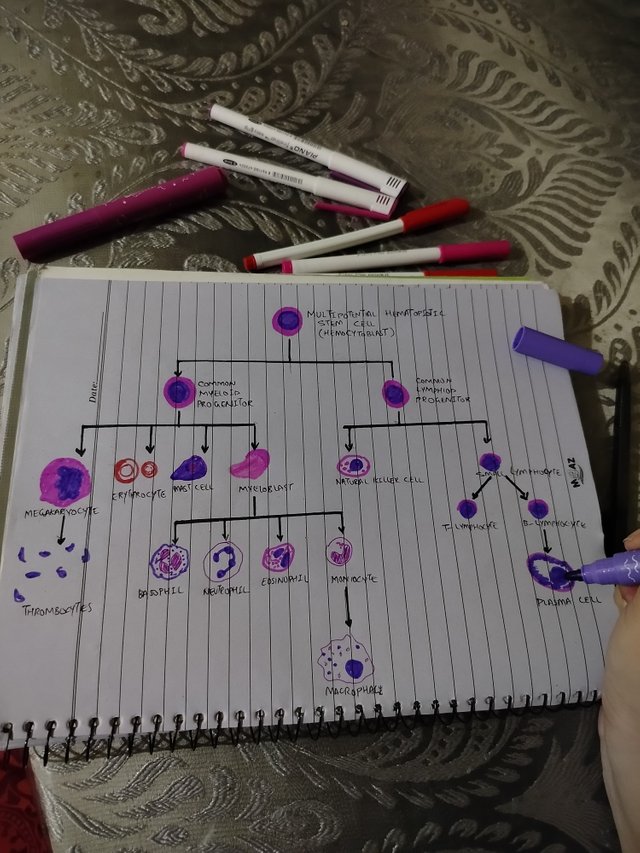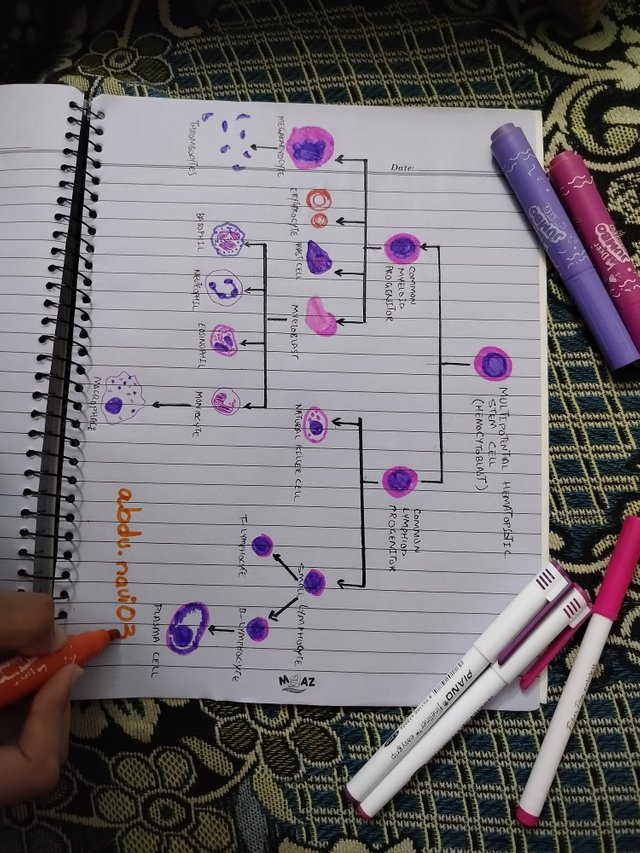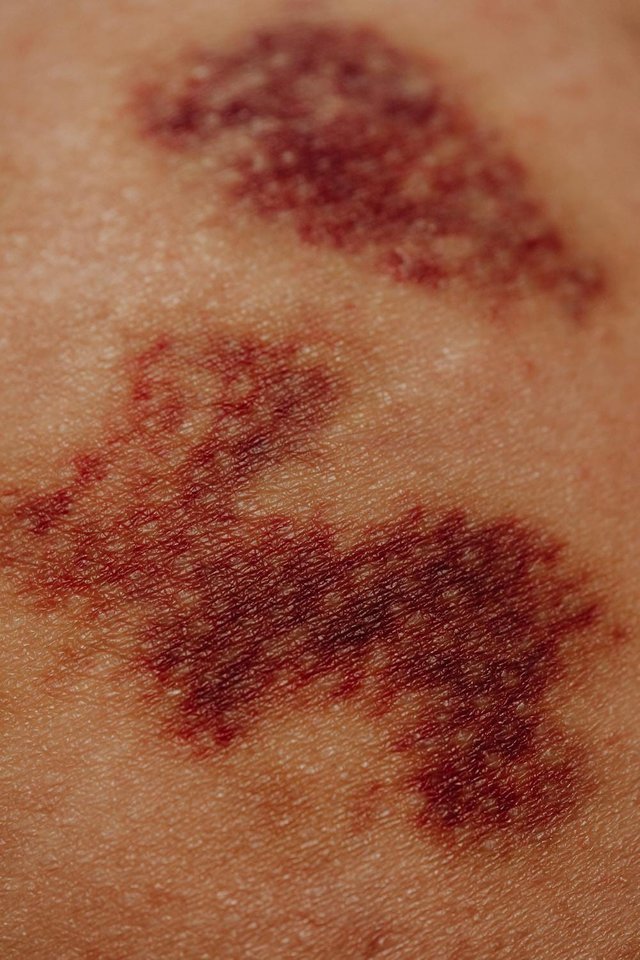SEC S20W1 || Hematopoiesis - Module 1
I’ve been eager to participate in various challenges, but my busy schedule has often kept me from joining as many as I would like. However, when it comes to medical-related topics, I couldn’t pass up the opportunity organized by @Dexsyluz. As a medical student, diving into the intricacies of hematopoiesis and sharing that knowledge is incredibly important to me. Teaching and learning about medical sciences is not only my passion but also a source of great satisfaction. While in-person teaching has its unique joys, I'm excited to explore and discuss these concepts through writing. In this post, I’ll break down the fundamentals of hematopoiesis, compare medullary and extramedullary hematopoiesis, and delve into the roles of various hematopoietic organs.
Introduction to Hematopoiesis and Its Organs |
|---|
Hematopoiesis is the process of blood cell formation. The term comes from two Greek words: "hemat-" meaning blood and "-poiesis" meaning making or creating. So, hematopoiesis literally means "making blood." This process is crucial because blood is essential for sustaining life by ensuring that every organ gets the oxygen and nutrients it needs.
Hematopoiesis primarily occurs in the bone marrow but can also happen in other organs like the liver and spleen, especially at different stages of human development. In this post, I'll break down the fundamentals of hematopoiesis, compare medullary and extramedullary hematopoiesis, and discuss the roles of various hematopoietic organs.

Anatomy and Function of Hematopoietic Organs |
|---|
Anatomy
Bone marrow is found within the cavities of bones throughout the body. The 206 bones are divided into the axial skeleton (skull, vertebral column, rib cage) and the appendicular skeleton (limbs and girdles). Hematopoiesis mainly occurs in long bones (femur, humerus), flat bones (sternum, ribs), vertebrae, and pelvic bones (ilium).
Physiology
Hematopoiesis in the bone marrow, also known as medullary hematopoiesis, produces all types of blood cells: red blood cells, white blood cells, platelets, and lymphocytes.
Anatomy
The liver is located in the right hypochondrium region of the abdomen, or the right upper quadrant. It consists of two main lobes: the right and left lobes.
Physiology
Often described as the body's "factory," the liver synthesizes various substances, degrades toxins, and metabolizes different elements. It is considered the largest organ in the body or the second-largest after the skin. The liver is integral to both the gastrointestinal and cardiovascular systems.
Anatomy
The spleen is situated in the left hypochondrium region, or the left upper quadrant of the abdomen.
Physiology
The spleen acts as the main filter of the body, focusing on filtering the blood. It removes infectious organisms and defective blood cells to prevent vascular obstruction and damage. It plays a critical role in the immune system, and the absence of the spleen in children can lead to severe infections.
Anatomy
The thymus is located in the mediastinum, behind the sternum, and between the two lungs.
Physiology
The thymus is crucial for preventing autoimmune diseases by ensuring that T-cells recognize and tolerate the body's own tissues, thus preventing autoimmune attacks.
Anatomy
Lymph nodes are distributed throughout the body in various locations and quantities, either within or surrounding different organs.
Physiology
Lymph is a colorless fluid that circulates through the lymphatic system, originating from interstitial fluid. It is collected by lymphatic vessels, transported to lymph nodes for filtration, and then returns to the bloodstream. Lymph nodes help maintain fluid balance, support immune function, and facilitate the removal of toxins and cellular debris from the body.
 |  |
|---|---|
| Source | Source |
Medullary Hematopoiesis vs Extramedullary Hematopoiesis |
|---|
Medullary Hematopoiesis
So now let's come to medullary hematopoiesis. Why is it called medullary? The term medullary refers to the inner part of the bone, which is usually the spongy and trabecular part of the bones. In medical terminology, medullary refers to the central or innermost part of any organ, like the medullary sponge kidney, which refers to the central or inner part of the kidney. So, medullary hematopoiesis refers to the process of blood cell production that occurs in the bone marrow cavity, which is the primary site for hematopoiesis. In healthy adults, the bone marrow of the pelvis, spine, ribs, and long bones is the main location for the production of red blood cells, white blood cells, and platelets.
Extra Medullary Hematopoiesis
Anything beyond medullary production of blood is called extramedullary hematopoiesis. When there are so many bones in our body, why is there a need for extramedullary hematopoiesis? In some patients, where there is a need for extra blood production, the body usually uses compensatory organs to produce additional blood. This includes the liver, spleen and sometimes lymph nodes in cases of severe blood need. Extramedullary hematopoiesis can be physiological, such as in cases of extreme blood loss or at certain stages of fetal development. However, extramedullary hematopoiesis is generally considered pathological when the bone marrow cannot produce blood cells. This can occur in diseases like leukemia, which is a cancer of the blood primarily affecting the bone marrow. There are also well-known diseases like sickle cell anemia and thalassemia, which are common in third-world countries. During my time in the medicine ward, I encountered these patients daily, and our diagnosis often involved palpating the liver and spleen, which are usually enlarged due to constant blood cell production. Additionally, hematopoiesis can start in unusual bones where it does not normally occur, such as in the face or skull, leading to chipmunk faces and crew cut appearances of the jawbone.
Hematopoiesis Diagram |
|---|
 |  |
|---|

Now let's come to the hematopoiesis diagram. In the diagram, you can see that there are two types of stem cells at the top, indicating that they can differentiate into all types of blood cells. The multipotent stem cells, known as hematopoietic stem cells, divide into two main progenitor cells: the myeloid progenitor cell and the lymphoid progenitor cell.
The myeloid lineage results in the production of various blood cells, including erythrocytes (red blood cells), eosinophils, basophils, neutrophils, and megakaryocytes (which produce platelets).
On the other hand, the lymphoid lineage is primarily involved in the adaptive immune system and forms T cells, B cells, and natural killer cells.
Clinical Case Discussion |
|---|
A 25-year-old male patient enters the emergency room of the Ruiz y Páez University Hospital Complex, with bruises all over his body as a result of a car crash. An order of tests is granted where they request Complete Hematology, Glycemia, Urea, Creatinine, Glomerular Filtration and Lipid Profile. The results of the tests show significant blood loss and problems with the kidneys, in addition to X-rays showing a broken femur. Explain the following in your own words:
Now, for the clinical case: If we talk about a case where bruises were found all over the body from a car crash, the bruises refer to traumatic body experiences that usually involve rhabdomyolysis (muscle breakdown) and hemorrhage from the trauma, resulting in blood accumulation in tissues, causing bruises and blood loss. Additionally, as indicated by the femur fracture, which is the largest bone in the human body, there is massive blood loss.

Whenever we encounter kidney dysfunction or kidney failure, the immediate concern related to hematology is usually reduced erythropoietin (EPO) levels. EPO is a chemical signal for the production of blood cells. Therefore, if the patient already has kidney problems, they might have anemia, a condition characterized by a deficiency in the number or quality of red blood cells or hemoglobin (the protein in red blood cells that carries oxygen to body tissues).
In your opinion, what are the reasons for the considerable blood loss?
Traumatic tissue breakdown, a femur fracture, and pre-existing anemia can lead to severe blood loss.
Who would be the ideal person to donate blood to? (profile of the ideal donor)
In emergency situations, the ideal blood donor compatible for this case would be O negative, as it can donate blood to anyone with any blood group and is considered a universal donor. However, if an emergency blood transfusion is not required, finding a compatible blood group based on the patient's blood type would be preferable, as O negative donors are relatively rare. It's important to ensure that the donor's blood is in good condition, with sufficient hemoglobin levels, and meets standard donation criteria, such as proper age, weight, and no history of infections like hepatitis or AIDS in recent months, along with other high-risk behaviors.
CONCLUSION |
|---|
In conclusion, hematopoiesis is a fundamental process that sustains life by constantly renewing the blood supply system. This case presented by the hematology team illustrates how the body's system can be severely disrupted in the event of trauma, highlighting the importance of understanding blood production and transfusion strategies. I am grateful to @Dexsyluz for organizing this challenge on hematopoiesis, which provided an excellent platform for delving into this critical topic. I hope this post helps you understand the fascinating world of hematology and provides a straightforward introduction to hematopoiesis, inspiring you to delve deeper into this life-saving field.
regards,
Dr @abdu.navi03
Your work is consistently brilliant, which is exactly what I’ve come to expect from you. The depth of your understanding is clear in all your medical blogs. The way you break down complex physiological concepts and explain clinical cases with your knowledge and expertise truly highlights your mastery. It’s evident that you excel in your field, and it shows just how exceptional you are at what you do. 🤙🤙
This is what I call posting something from your own knowledge and not through the internet. Way to go doctor.
Thankyou Brother. These words from a dear one means a lot to me. Always appreciate your support and encouragement that keeps me motivated to put my best in each post.
Hola amigo, hiciste un muy buen trabajo con la explicacion de cada una de las preguntas, te felicito
podrías prestar atención a las imágenes por favor ? siempre es necesario que sean imágenes libres de derecho de autor
Thanks for the appreciation! Yes, I missed double-checking the picture, but I've changed it now. I appreciate you letting me know